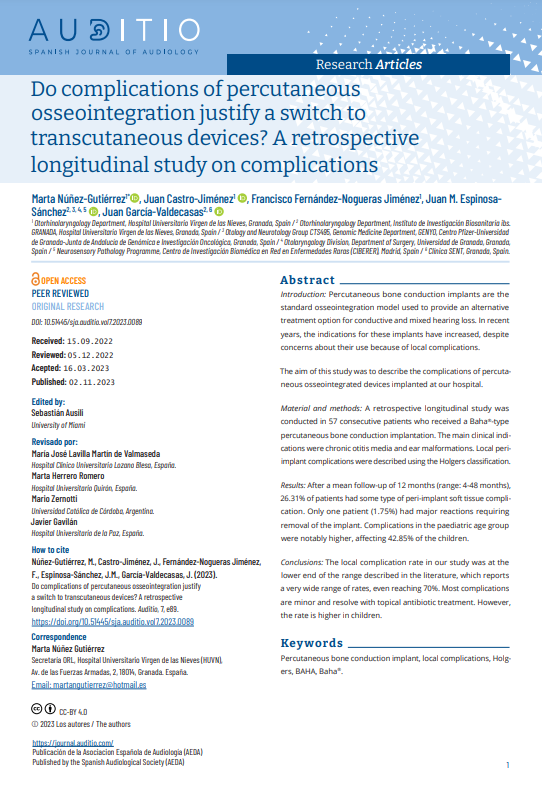Do complications of percutaneous osseointegration justify a switch to transcutaneous devices? A retrospective longitudinal study on complications
DOI:
https://doi.org/10.51445/sja.auditio.vol7.2023.0089Keywords:
Percutaneous bone conduction implant, local complications, Holgers, BAHAAbstract
Introduction: Percutaneous bone conduction implants are the standard osseointegration model used to provide an alternative treatment option for conductive and mixed hearing loss. In recent years, the indications for these implants have increased, despite concerns about their use because of local complications. The aim of this study was to describe the complications of percutaneous osseointegrated devices implanted at our hospital.
Material and methods: A retrospective longitudinal study was conducted in 57 consecutive patients who received a Baha®-type percutaneous bone conduction implantation. The main clinical indications were chronic otitis media and ear malformations. Local periimplant complications were described using the Holgers classification.
Results: After a mean follow-up of 12 months (range: 4-48 months), 26.31% of patients had some type of peri-implant soft tissue complication. Only one patient (1.75%) had major reactions requiring removal of the implant. Complications in the paediatric age group were notably higher, affecting 42.85% of the children.
Conclusions: The local complication rate in our study was at the lower end of the range described in the literature, which reports a very wide range of rates, even reaching 70%. Most complications are minor and resolve with topical antibiotic treatment. However, the rate is higher in children.
Downloads
Visibility and Altmetrics
Metrics
Global Statistics ℹ️
|
887
Views
|
2117
Downloads
|
|
3004
Total
|
|
References
Brånemark, R., Brånemark, P. I., Rydevik, B., & Myers, R. R. (2001). Osseointegration in skeletal reconstruction and rehabilitation: a review. J Rehabil Res Dev., 38(2), 175–181.
Brenner, M. J., Goebel, J. A., & Wippold, F. J., 2nd (2007). Insufficient cranial thickness in bone-anchored hearing aid placement. Otology & neurotology : official publication of the American Otological Society, American Neurotology Society [and] European Academy of Otology and Neurotology, 28(6), 865–866. https://doi.org/10.1097/MAO.0b013e318030b042
Calon, T. G. A., Johansson, M. L., de Bruijn, A. J. G., van den Berge, H., Wagenaar, M., Eichhorn, E., Janssen, M. M. L., Hof, J. R., Brunings, J. W., Joore, M. A., Jonhede, S., van Tongeren, J., Holmberg, M., & Stokroos, R. J. (2018). Minimally invasive ponto surgery versus the linear incision technique with soft tissue preservation for bone conduction hearing implants: A multicenter randomized controlled trial. Otol Neurotol., 39(7), 882–893. https://doi.org/10.1097/MAO.0000000000001852
Cass, S. P., & Mudd, P. A. (2010). Bone-anchored hearing devices: indications, outcomes, and the linear surgical technique. Oper Tech Otolaryngol Head Neck Surg;21:197–206. https://doi.org/10.1016/j.otot.2010.05.004
Chen, S. Y., Mancuso, D., & Lalwani, A. K. (2017). Skin necrosis after implantation with the BAHA attract: A case report and review of the literature. Otol Neurotol., 38(3), 364–367. https://doi.org/10.1097/MAO.0000000000001327
Cooper, T., McDonald, B., & Ho, A. (2017). Passive transcutaneous bone conduction hearing implants: A systematic review. Otol Neurotol., 38(9), 1225–1232. https://doi.org/10.1097/MAO.0000000000001518
den Besten, C. A., Bosman, A. J., Nelissen, R. C., Mylanus, E. A., & Hol, M. K. (2016). Controlled clinical trial on bone-anchored hearing implants and a surgical technique with soft-tissue preservation. Otol Neurotol., 37(5), 504–512. https://doi.org/10.1097/MAO.0000000000000994
den Besten, C. A., Nelissen, R. C., Peer, P. G., Faber, H. T., Dun, C. A., de Wolf, M. J., Kunst, H. P., Cremers, C. W., Mylanus, E. A., & Hol, M. K. (2015). A retrospective cohort study on the influence of comorbidity on soft tissue reactions, revision surgery, and implant loss in bone-anchored hearing implants. Otol Neurotol., 36(5), 812–818. https://doi.org/10.1097/MAO.0000000000000745
de Souza, M. A., Vallejos Riart, S. L., Souza, S. R., de Brito, R., & Bento, R. F. (2022). Complications of transcutaneous protheses - A systematic review of publications over the past 10 years. Int Arch Otorhinolaryngol., 26(3), e505–e512. https://doi.org/10.1055/s-0042-1742352
de Wolf, M. J., Hol, M. K., Huygen, P. L., Mylanus, E. A., & Cremers, C. W. (2008). Nijmegen results with application of a bone-anchored hearing aid in children: simplified surgical technique. Ann Otol, Rhinol Laryngol., 117(11), 805–814.
https://doi.org/10.1177/000348940811701103
Dufour-Fournier, C., Devèze, A., Barbut, J., Ogam, E., Saliba, I., & Masson, C. (2022). Analysis of the acoustic transcranial bone conduction. Audiol Res., 12(2), 162–170. https://doi.org/10.3390/audiolres12020019
Dun, C. A., Faber, H. T., de Wolf, M. J., Mylanus, E. A., Cremers, C. W., & Hol, M. K. (2012). Assessment of more than 1,000 implanted percutaneous bone conduction devices: skin reactions and implant survival. Otol Neurotol., 33(2), 192–198. https://doi.org/10.1097/MAO.0b013e318241c0bf
Ellsperman, S. E., Nairn, E. M., & Stucken, E. Z. (2021). Review of bone conduction hearing devices. Audiol Res., 11(2), 207–219. https://doi.org/10.3390/audiolres11020019.
Johansson, M. L., Stokroos, R. J., Banga, R., Hol, M. K., Mylanus, E. A., Savage Jones, H., Tysome, J. R., Vannucchi, P., Hof, J. R., Brunings, J. W., van Tongeren, J., Lutgert, R. W., Banerjee, A., Windfuhr, J. P., Caruso, A., Giannuzzi, A. L., Bordin, S., Hanif, J., Schart-Morén, N., … Hultcrantz, M. (2017). Short-term results from seventy-six patients receiving a bone-anchored hearing implant installed with a novel minimally invasive surgery technique. Clin Otolaryngol., 42(5), 1043–1048. https://doi.org/10.1111/coa.12803
Kiringoda, R., & Lustig, L. R. (2013). A meta-analysis of the complications associated with osseointegrated hearing aids. Otol Neurotol., 34(5), 790–794. https://doi.org/10.1097/MAO.0b013e318291c651.
Kraai, T., Brown, C., Neeff, M., & Fisher, K. (2011). Complications of bone-anchored hearing aids in pediatric patients. Int J Pediatr Otorhinolaryngol., 75(6), 749–753. https://doi.org/10.1016/j.ijporl.2011.01.018
Lagerkvist, H., Carvalho, K., Holmberg, M., Petersson, U., Cremers, C., & Hultcrantz, M. (2020). Ten years of experience with the Ponto bone-anchored hearing system: A systematic literature review. Clin Otolaryngol., 45(5), 667–680. https://doi.org/10.1111/coa.13556
Lavilla Martín de Valmaseda, M. J., Cavalle Garrido, L., Huarte Irujo, A., Núñez Batalla, F., Manrique Rodriguez, M., Ramos Macías, Á., de Paula Vernetta, C., Gil-Carcedo Sañudo, E., Lassaletta, L., Sánchez-Cuadrado, I., Espinosa Sánchez, J. M., Batuecas Caletrio, Á., & Cenjor Español, C. (2019). Clinical guideline on bone conduction implants. Guía clínica sobre implantes de conducción de vía ósea. Acta Otorrinolaringol Esp (Engl Ed)., 70(2), 105–111. https://doi.org/10.1016/j.otorri.2017.12.001
Mohamad, S., Khan, I., Hey, S. Y., & Hussain, S. S. (2016). A systematic review on skin complications of bone-anchored hearing aids in relation to surgical techniques. Eur Archs Otorhinolaryngol., 273(3), 559–565. https://doi.org/10.1007/s00405-014-3436-1
Olsen, S. Ø., Glad, H., & Nielsen, L. H. (2011). Comparison between two bone-anchored hearing instruments: BP100 and Ponto Pro. Int. J. Audiol, 28(8), 1107-1112. https://doi.org/10.3109/14992027.2011.605806
Reinfeldt, S., Håkansson, B., Taghavi, H., & Eeg-Olofsson, M. (2015). New developments in bone-conduction hearing implants: a review. Medical devices (Auckland, N.Z.), 8, 79–93. https://doi.org/10.2147/MDER.S39691
Roman, S., Nicollas, R., & Triglia, J. M. (2011). Practice guidelines for bone-anchored hearing aids in children. Eur Ann Otorhinolaryngol Head Neck Dis., 128(5), 253–258. https://doi.org/10.1016/j.anorl.2011.04.005
Schwab, B., Wimmer, W., Severens, J. L., & Caversaccio, M. D. (2020). Adverse events associated with bone-conduction and middle-ear implants: A systematic review. Eur Archs Otorhinolaryngol., 277(2), 423–438. https://doi.org/10.1007/s00405-019-05727-8
Siau, R. T., Dhillon, B., Siau, D., & Green, K. M. (2016). Bone-anchored hearing aids in conductive and mixed hearing losses: why do patients reject them?. Eur Archs Otorhinolaryngol., 273(10), 3117–3122. https://doi.org/10.1007/s00405-016-3941-5
Strijbos, R. M., Salameh, S., Bezdjian, A., Daniel, S. J., & Thomeer, H. G. (2022). The minimally invasive star-shaped incision technique and the linear incision technique with tissue preservation for percutaneous bone conduction devices: A Retrospective cohort study. Front Surg., 9, 863997. https://doi.org/10.3389/fsurg.2022.863997
Tamarit Conejeros, J. M., Dalmau Galofre, J., Murcia Puchades, V., Pons Rocher, F., Fernández Martínez, S., & Estrems Navas, P. (2009). Comparison of skin complications between dermatome and U-graft technique in BAHA surgery. Acta Otorrinolaringol Esp (Engl Ed)., 60(6), 422–427. https://doi.org/10.1016/j.otorri.2009.06.005
Tjellström, A., Håkansson, B., & Granström, G. (2001). Bone-anchored hearing aids: current status in adults and children. Otolaryngologic clinics of North America, 34(2), 337–364. https://doi.org/10.1016/s0030-6665(05)70335-2
Tjellström, A., Lindström, J., Hallén, O., Albrektsson, T., & Brånemark, P. I. (1981). Osseointegrated titanium implants in the temporal bone. A clinical study on bone-anchored hearing aids. Am J Otol., 2(4), 304–310.
Verheij, E., Bezdjian, A., Grolman, W., & Thomeer, H. G. (2016). A Systematic Review on Complications of Tissue Preservation Surgical Techniques in Percutaneous Bone Conduction Hearing Devices. Otol Neurotol., 37(7), 829–837. https://doi.org/10.1097/MAO.0000000000001091
Verstraeten, N., Zarowski, A. J., Somers, T., Riff, D., & Offeciers, E. F. (2009). Comparison of the audiologic results obtained with the bone-anchored hearing aid attached to the headband, the testband, and to the "snap" abutment. Otol Neurotol., 30(1), 70–75. https://doi.org/10.1097/MAO.0b013e31818be97a
Yuen, H. W., Bodmer, D., Smilsky, K., Nedzelski, J. M., & Chen, J. M. (2009). Management of single-sided deafness with the bone-anchored hearing aid. Otolaryngol Head Neck Surg., 141(1), 16–23. https://doi.org/10.1016/j.otohns.2009.02.029
Zernotti, M. E., & Sarasty, A. B. (2015). Active bone conduction prosthesis: Bonebridge(TM). Arch Otorhinolaryngol., 19(4), 343–348. https://doi.org/10.1055/s-0035-1564329

Downloads
Published
How to Cite
License
Copyright (c) 2023 Marta Núñez, Juan Castro Jiménez, Francisco Fernández-Nogueras Jiménez, Juan Manuel Espinosa Sánchez, Juan Garcia-Valdecasas Bernal

This work is licensed under a Creative Commons Attribution 4.0 International License.
All articles will be published under the open Creative Commons Attribution (CC-BY) license. This license allows others to share and adapt the content, even for commercial purposes, as long as appropriate credit is given to the authors and the journal. By submitting their manuscript, authors retain copyright but grant the journal the right to make the first publication under this license.
More information about this license is available at: https://creativecommons.org/licenses/by/4.0/
Articles published between 2001 and 2020
The texts published in this journal in the section "AUDITIO 2001-2020" are subject - unless otherwise indicated - to a Creative Commons Attribution 3.0 Spain license. You can copy, distribute, communicate them publicly, make derivative works and commercial uses provided that you acknowledge the credits of the works (authorship, name of the journal, publishing institution) in the manner specified by the authors or by the journal. The full license can be consulted at http://creativecommons.org/licenses/by/3.0/es/deed.es.









